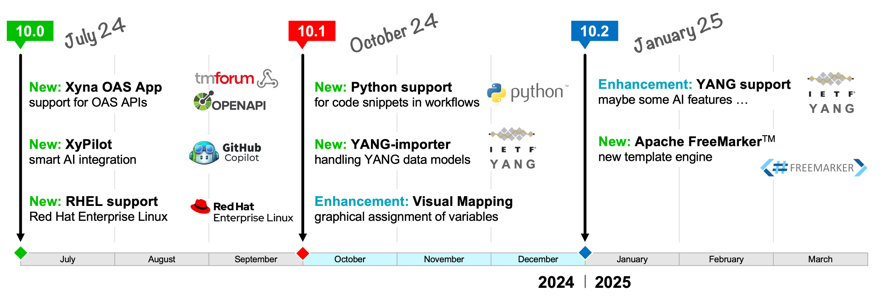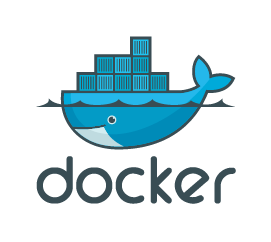Xyna 10 :: The Next Generation
Xyna Bulletin #15
Dear friends, partners and customers of Xyna,
☀️ While summer is raging outside, we would like to bring a little light into the shady corners with a new bulletin. To where all of us, who have already had our summer vacation or are still looking forward to it, retreat. ☀️
A big birthday was coming up - which we of course celebrated appropriately: with a firework of exciting new functions:

Anyone who has known Xyna for a while knows that the major version numbers are not based on years, but on relevant technological leaps. And with the introduction of artificial intelligence into workflow automation (XyPilot) and an extensive new feature set around generic support for OAS-based interfaces (Xyna OAS App), such a point has been reached.
Stay tuned and take a look at the sources (GitHub) or use the brand new image on Dockerhub directly.
Enjoy reading!
Kind regards from Mainz,
Philipp
Xyna GmbH Dr. Alexander Ebbes & Philipp Dominitzki
PS: Do you know colleagues who are also interested in the topic of Xyna? Then please spread the word! A short reply with contact details to bulletin@xyna.com is enough. If you are not interested, just send a short email and we will remove you from the mailing list.
::
Xyna 10: The Next Generation
The story of Xyna begins in 2003/2004, when we saw potential for product development based on requirements in consulting and development projects with various providers: the goal of a flexible configuration of IP products in the then emerging "Next Generation Network". The DNA of the GIP ("Society for Industrial Physics") contained the basis for industrial production - and so the Xyna Service Factory was created, a platform for the process-oriented and order-controlled production of IP services.
Over the years, Xyna has undergone a whole series of changes. While the first versions still relied on third-party workflow engines (the "Red Edition" on Oracle Fusion Middleware, the "Blue Edition" on IBM WebSphere, ...), the foundations of the self-developed software stack that still form the cornerstones of Xyna today were created from 2010 onwards: the Fractal Modeller, the XMOM Master Object Management or the self-similar modularized structure of the Factory Module with Departments, Sections and Function Groups.
From this point of consistent focus on a self-developed product, a line leads to the year 2022, where the change from a proprietary licensing model to an open source approach again marked an important turning point in Xyna's product development.
Today, Xyna is in excellent health in an open approach, accompanied and supplemented by models for commercial security for use in critical infrastructures and complementary consulting and project offers from GIP Exyr.
Demonstrated as a preview at the TM Forum in Copenhagen and now, almost 20 years after Xyna 1, the best Xyna ever is available:

The format of the Bulletin newsletter is hardly suitable for fully covering the variety of new functions and updates to known features. Therefore, in the coming issues of the Bulletin, we will be taking a closer look at the world of Xyna 10, bit by bit.
For here and now, the highlights:
- XyPilot - your AI partner: XyPilot uses artificial intelligence (GitHub CoPilot) to help you create and optimize coded services, data models and documentation.
- Xyna OAS App: offers generic support for OAS APIs, including the increasingly popular and important TM Forum Open APIs. This makes building OAS-compliant architectures child's play and enables seamless integration into corresponding system landscapes.
- Xyna Test Factory: Long Time no See --- the Test Factory is back, and with it the paradigm with which we were able to celebrate a breakthrough in the field of process-oriented testing many years ago: testing processes with processes.
Xyna Visual Mapping: it has never been so easy to marry complex data structures from different sources and with different sinks.
Xyna 10 is just waiting for you. If you like things a little more raw, you can download the source repositories on GitHub. And for the easy-going faction, a ready-made image on Dockerhub is just waiting to be started with a click of the mouse.
 | ||
You're rightly excited about what awaits you. And our offer again: we'd be happy to look around the area with you. Help with the first steps... think about how use cases can be implemented... in an uncomplicated way and through the shortest possible channels. Get in touch!
::
Xyna Roadmap / more to come
The current Xyna version 10.0 has been available since July. Our team is currently working with mid-summer enthusiasm on the next version 10.1, which will be released in October. And we already have a number of great and important ideas for the following release 10.2 at the beginning of next year:

What you can expect soon:
- Python support: has long been on our list of ideas, now in the works: so far, you could only program in Java in the workflow-integrated Xyna code snippets, soon also in Python. Lightweight, contemporary, versatile. Both languages have their advantages and justification - and in addition to personal preferences and previous knowledge, there are also concrete advantages of Python such as transparency and speed.
- YANG importer: the RFC for YANG will soon celebrate its 15th birthday and the modeling language has certainly not fulfilled all the expectations that were once associated with it in these years. It has neither definitively ushered in the SDN era nor has it replaced all other methods for modeling configurations. But YANG is enjoying a certain popularity, especially in the Cisco environment, and there is no doubt that in combination with NETCONF interesting functions for controlling network elements arise. We are currently evaluating the range of possibilities for how Xyna could handle YANG models and how the interaction between Xyna and YANG with NETCONF as the transport protocol should ideally look. A first step will be the import of YANG models so that parameters and data structures are integrated in the Xyna XMOM universe. ... further thoughts will lead us in the coming months towards AI-controlled networks, AI Network Operations & Co.
As always, the following applies here too: if you are interested in one or more topics on the roadmap, want to take a look at a beta version of the Xyna development, have exciting use cases or even new ideas: get in touch!
Because the Xyna roadmap is not a fixed star with an unchangeable position in the development sky. New features and extensions are not an end in themselves but always relate to specific requirements from projects or to necessities from the further development of the technology environment. We are and will remain flexible and open to your suggestions.
